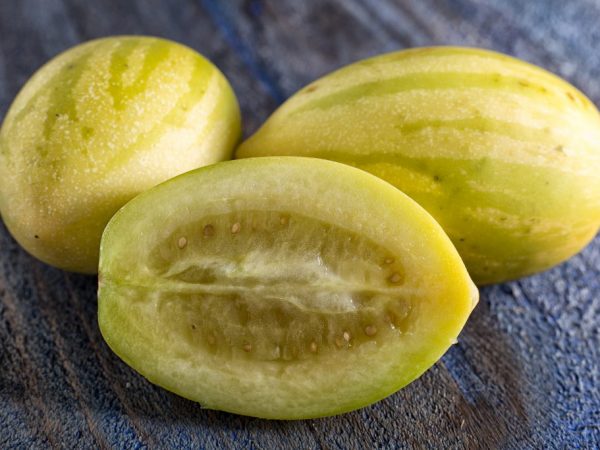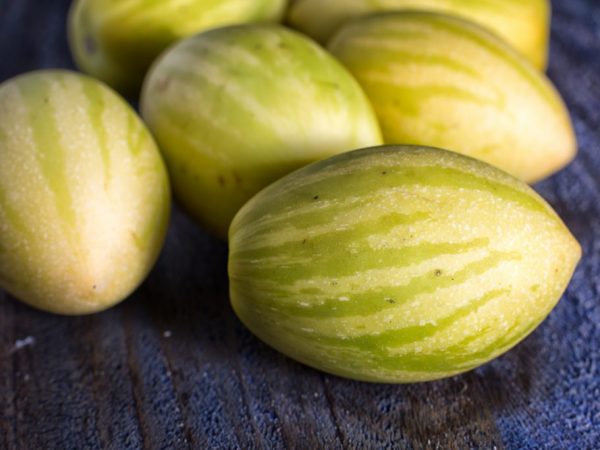Melon Pear Description
The Pepino variety is popular among Russian gardeners and summer residents. There are many variety names - pear melon, melon pear or Pepino. It differs in that the shape of the fruit is pear-shaped, and the taste resembles a melon. Melon pear is ideal for lovers of delicious and sweet fruits. We will consider a detailed description of the variety in the article.

Melon Pear Description
Characteristics of the variety
Melon pear originated in South America. Work on breeding the variety began at the beginning of the century. In the middle of the century, this variety was sent for research. To date, there is no reliable information on the registration of the species.
Depending on the area, cultivation is carried out in the open field, greenhouses and even on balconies. For the climate of Russia, such separate varieties as Consuelo and Ramses were bred. The variety is high in vitamins B and C, iron and carotene. Perfect for fresh consumption or making diet salads. Quite often, desserts are prepared from it or canned for the winter.
The appearance of the tree
Branched shrubs of low height. The height of the tree does not exceed 1.5 m. The diameter of the stems is only 8 mm. The appearance of the leaves depends on the variety. Melon pear can have either simple leaves (resembling pepper), or lobed, like tomatoes. The shade of the foliage can vary from light green to dark green. Pepino inflorescences consist of white or pink flowers. The root system is well developed and located at a depth of no more than 3 cm.Despite the fact that the biological structure of the bush, this species belongs to vegetables, gardeners still consider it a fruit tree, and the sweet taste and pleasant aroma only confirms this opinion.
Features of the fruit
Melon pear has fruits of different weights (from 3 g to 1.5 kg), colors (yellow, white, beige and even purple) and shapes (elongated, pear-shaped, round or flattened). The average length of the fruit is 15 cm. The skin of the fruit is transparent and the flesh is visible through it. The surface of the peel is smooth and glossy. The taste is pleasant, sweet, but it is customary to peel the fruit, because it can taste a little bitter.
Varieties of varieties
Consuelo
The Consuelo variety is characterized by purple stems. The height of the bush reaches m. The shape of Consuelo's fruits is round, and their weight is about 1 kg. After ripening, the fruits acquire a rich creamy hue, with rare purple stripes. About 7 fruits are formed on each cluster. But experts recommend leaving only 1 ovary so that the bush does not deform from the large weight of the fruit. Reproduction of this species occurs only with the help of cuttings, since the fruits do not form seeds.
Ramses
The Ramses variety is shade or drought tolerant. Its main feature is that it can form additional fruits in the autumn season, without additional lighting. The stems are green with small spots of purple.The fruits are oval in shape and their weight is about 5-6 g. The seeds inside the fruit are rather small and their number can reach up to 1 pc.
Growing by seeds

We plant with seeds
Despite the fact that the melon pear is classified as a perennial plant, in Russia it needs to be planted every year. In order for the seedlings to form at the end of spring, the seeds are planted in the middle of autumn. For planting seeds, special containers should be used, which, after planting, are covered with foil or glass. The planting depth of seeds should be no more than 5 cm. Seed germination should be carried out only at a certain temperature of 8-3 ° C. Weeks later, when roots appear on the seeds, you need to place the containers to the lamp. Until the cotyledons are formed, the seeds should be illuminated for 4 hours a day. The containers must be ventilated every day. To do this, raise the glass or film for 3-4 seconds. After 5 days, the containers need to be illuminated only 1 hour a day. At the beginning of March, lighting should be completely stopped. As soon as several formed leaves appear on the seedlings, they need to be transplanted into separate containers. The soil for growing seedlings should be light and good for air conduction. Before picking, the planting material must be treated with a fungicidal solution.
Growing by cuttings
The main feature of the melon pear is that it can propagate vegetatively, that is, using cuttings. Stepsons, which are obtained even from young seedlings, are better subject to rooting, which significantly increases the number of planting material. In this case, flowering and fruiting occurs much earlier than in plants from seeds.
To obtain cuttings, you need to cut the bush by 1/3 in the autumn season, dig it up and plant it in a 1-liter bucket. After that, you need to take the bucket to a greenhouse or a well-heated room. For 6 days, the plant should be kept at a temperature of 1 ° C, and watering should be reduced to 1 time per week. In mid-February, the room temperature should be raised to 17 ° C. From this point on, watering should be carried out once a week. You should also apply organic fertilizers in the form of humus or bird droppings. When the buds appear, they should be removed, and the resulting stepchildren begin to grow in light soil. The root system of cuttings will develop correctly only if the room humidity is at least 85%.
Care
Seedlings need proper care. First of all, you need to water the plant every 5-6 days. Top dressing is carried out using organic matter or mineral fertilizers (nitrogen or phosphorus). The young melon pear can be affected by certain parasites and diseases. To protect the planting material, the plant should be inspected daily for the presence of parasites and sprayed with acaricidal substances once every 1 day.
Growing in a greenhouse
Since the Pepino plant belongs to heat-loving plants, it must be grown in a greenhouse or greenhouse. When the seedlings reach the age of 3-4 months, they begin to plant them in the greenhouse. There should be no more than 3 bushes per 1 m. Planting should be carried out only at the moment when the soil is warmed up to a temperature of ° C. The optimum air temperature is 3-4 ° C during the daytime and 15-18 ° C at night. Early planting of Pepino can significantly increase the amount of yield. Planting in May negatively affects the development of the bushes (fruits cannot set). If you plant seeds in the fall, you will be able to plant the planting material in the greenhouse at the beginning of spring.
Care
Caring for Pepino in a greenhouse consists of several stages:
- Watering should be done once a week.
- Every 1 day, fertilizers must be applied under the root using humus and phosphorus-potassium substances.
- You also need to spray the bushes once a week with drugs that stimulate the growth of bushes and increase the immune system of plants (Zircon or Arax).
- Do not forget that it is important to ventilate the room every day. The windows in the greenhouse should be opened for several hours. Airing is necessary to prevent parasites and improve yields.
Conclusion
Melon pear cultivation should be carried out according to the principle of room culture: the plant needs lighting, feeding, watering and processing. Planting seeds or getting cuttings is possible at any time of the year. If you follow all of the above rules, you can grow a healthy bush that will delight you with delicious and healthy fruits every year.

